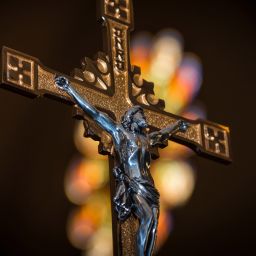By Father Thomas Esposito, O. Cist.
Special to The Texas Catholic
I was in an allegorizing mood last week when I visited the church of San Carlo alle Quattro Fontane in the heart of Rome. Designed by the 17th century architect Francesco Borromini, San Carlo is a jewel of astonishing beauty on the corner of a busy intersection. The tall façade features columns, windows, and sculptures that undulate in convex and concave waves; Borromini had the unique talent of making stone billow like a bedsheet in the wind. Sadly, layers of urban grime, smoke, and exhaust fumes have dirtied the majestic façade, giving this masterpiece of Baroque art a dilapidated appearance.
The interior, made of white stucco, is a feast of stunning geometric elegance. The floor plan takes an oval shape, and the nave has the same dramatic movement of convex and concave waves evident on the façade. The coffered oval dome is composed of mesmerizing octagons, crosses, and hexagons, all of which compel the eye to soar upward. At the narrow summit of the oval dome, a golden circle contains a white dove within a triangle, bathed in light entering from hidden windows. Borromini’s architectural genius unveils to us a glimmer of the infinite mystery of God, the cosmic geometer who arranges everything in proper order. It is a privilege to pray in a place where the human creator so beautifully channels the genius of the Creator who is Beauty itself.
Curiously, all the niches in the nave are empty; the absence of statues is highlighted by the illumination of the niches with soft golden light. Their barrenness prompted me to construct an allegory. I see the church of San Carlo as a fitting representation of the state of the Catholic faith today in Italy and Europe at large. Although the church is still a functioning parish and has not been reduced to a museum requiring an entrance fee, its tarnished façade suggests that the locals are willing to watch it become a ruined relic. The empty niches inside reinforce the suspicion that the Catholic Church of today has nothing positive to offer, and that even the saints of old cannot speak to secularized visitors. Those who come may admire the beauty of the place without any vital commitment of faith, content to regard the structure once built for prayer as merely the quaint object of interest for art history lovers.
But my pessimistic allegory yields to a more positive reading. I find the hollow niches to be both aesthetically pure and strangely consoling. I take the absence of statues in those niches as a reminder for saints-in-the-making to think of their own minds and hearts as niches or tabernacles eager to receive the presence of God in the Eucharist and in the life of grace. The goal of sanctity, of course, is not to be canonized publicly or immortalized in a sculpture, but the empty niches cry out to be fitted, so to speak, with the glorious deeds of a new generation of Catholics who love beauty and wish to share the incarnated Gospel with a world unknowingly thirsting for the Source of beauty and truth.
Despite the degrading black soot, the neglected façade declares a venerable faith that still fascinates, one that remains capable of drawing outsiders in. And once inside, the fresh radiance of the well-kept nave and cupola conspire to inspire awe in someone disposed to be moved by the formal beauty of the place. Beauty might not save the world, but it can enkindle a tremendous desire for the origin of that beauty. To look at the church as if I believed that the God worshiped here is indeed the cosmic geometer whose presence called forth the genius of Borromini, and whose love binds everything together in harmony: such thoughts could generate prayer in the niche of a soul made to welcome God. They also assure me that even today, the wonder engendered by a beautiful church can lead souls to desire, and even adopt, the alluring geometry of faith as the pattern for their life.
Father Thomas Esposito, O. Cist., is a monk at the Cistercian Abbey of Our Lady of Dallas and teaches in the theology department at the University of Dallas.















